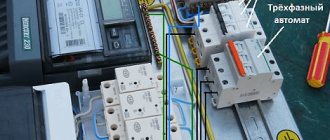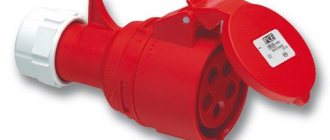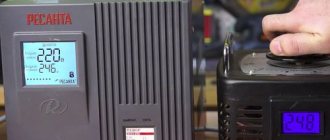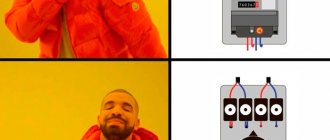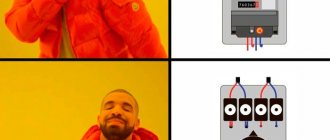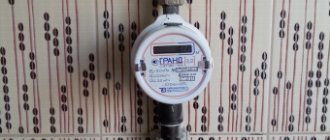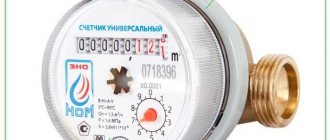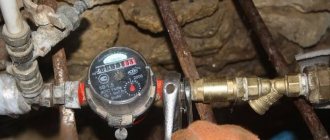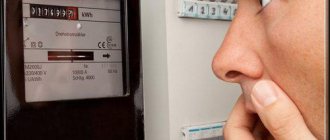Expert author of the article
Olga Ivanovna Avtushko
Leading civil engineer in a construction and installation organization. Work experience - 19 years.
Electricity distribution companies are forcing owners of private houses to install metering panels on the street. The electronic meter on the pole is a cause of disagreement and controversy. Each side pursues its own interests. It is important for suppliers that their energy is not stolen. Consumers are concerned about payments. Advanced technologies, compliance with laws and installation requirements solve the problem.
Our advantages
Our specialists have extensive experience and professional skills in the field of electrical installation work.
In addition to installing the meter itself, we offer installation of a power limiter, an input circuit breaker, an RCD, and an electrical panel. We carry out the work promptly and efficiently, and provide a 12-month guarantee. The cost of installing an electric meter on a pole depends on several conditions:
- location height;
- meter configuration and type;
- support material;
- fastening method;
- Availability of additional services (laying cables in pipes, activating machines, installing an electrical panel, etc.)
Cost of work
| Name of service | Price |
| Installation of a 15 kW pipe stand | 17900 rub. |
| Removal of an electric meter up to 7 kW to poles | 11200 rub. |
| Removing the electric meter to a 5 meter pipe stand 5 kW | 15900 rub. |
| Installation of a pipe stand 6 meters at 15 kW | 18900 rub. |
| Installation of a pipe stand 7 meters at 15 kW | 23900 rub. |
| Increase in power up to 15 kW | from 6000 rub. |
ᐈ Installation of an Electricity Meter Kyiv - Price 2022 for Connecting an Electricity Meter
The All-Ukrainian TV channel in the program “Breakfast with 1+1” interviewed Roman Kirigetov, the founder of the Kabanchik.ua project, live about how the service works and how to safely order the services of private specialists in Ukraine.
For legal fixed electricity consumption, you need to install an electric meter - a service for installing and connecting a device that will keep records.
Correctly connecting an electric meter is a rather complicated procedure.
In this case, it is important to follow all connection rules, otherwise the meter will not be accepted for operation by a representative of the regulatory authority
So, it would be best to entrust this task to a professional electrician.
Rules for installing a meter, or why it is difficult
The general list of stages is significantly influenced by the type of metering device: depending on its mechanism, complexity and features, the sequence of work will be determined. In the standard version, the wizard performs the following actions:
Installation of the meter. Installation of the electric meter begins with fixing the device in the electrical panel housing using the screws included in the kit. At the same stage, automatic switches are installed on the DIN rail of the electrical panel to ensure safe operation of the electrical wiring.
Tire installation. At this stage, the specialist installs the protective grounding bus in the electrical panel housing on a DIN rail or support insulators
During the installation process, it is important to eliminate any risk of short circuits. Load connection
Phase conductors are connected to the lower terminals of the circuit breakers. The neutral conductor is connected to the corresponding bus, the ground wire is connected to the ground bus. The upper contacts of the circuit breakers are connected using jumpers.
Connecting the meter. To correctly install the electric meter, you need to use a conductor to connect the “phase” contact of the metering device with the upper contacts of the circuit breakers. The “zero” of the counter is connected to the zero bus. Having carried out these operations, the technician will secure the device in the electrical panel opposite the window for taking readings.
Trial. The installed meter is checked at idle, then gradually increasing the load. If everything is in order, you can call the controller to seal the meter. There will be no problems with its acceptance into operation.
How to quickly install an electric meter?
The installation speed of an electric meter depends on several points:
- type of electricity meter;
- site preparation (presence or absence of an electrical panel);
- master's experience;
- comfortable working conditions.
Price: Installation and replacement of an electric meter in Kyiv 2020
| Single-phase single-tariff | from 300 UAH |
| Single-phase multi-tariff | from 400 UAH |
| Three-phase direct connection | from 500 UAH. |
| Dismantling | from 150 UAH |
| Replacement or installation on a pole or support | from 800 UAH |
| Dismantling on a pole or support | from 600 UAH |
*Price current as of May 2020
Do you want to quickly install an electric meter in Kyiv with guarantees? Are you planning to spend the optimal amount and get high quality? It's real: just create a task on the Kabanchik website.
ua, and in a few minutes you will be able to choose an experienced, proven electrician with a good rating and positive feedback from customers. Using the service is a guarantee of an economical and safe service.
- Installation of overhead socket - from 50 UAH.
- Installation of surface-mounted switch - from 250 UAH.
- Switch relocation - from 200 UAH.
- Assembly of a chandelier - from 80 UAH.
- Installation of a doorbell - from 150 UAH.
- Installing a machine instead of a traffic jam - from 200 UAH.
- Installation of the meter - from 400 UAH.
- Installation of video surveillance - from 1500 UAH.
If you use the services of a master, the cost of the visit will be 0 UAH, but if the master advises you, but does not perform the work, the cost of the visit will be 150 UAH.
All our specialists undergo passport data verification. If you encounter an unscrupulous specialist, contact the support service for compensation of up to 1,000 UAH.
We work in all districts of Kyiv: Goloseevsky, Darnitsky, Desnyansky, Dneprovsky, Obolonsky, Pechersky, Podolsky, Svyatoshinsky, Solomensky, Shevchenkovsky.
Electronic counter with remote control
When all apartments had induction electric meters, craftsmen invented various ways to change their readings downwards. With the advent of electronic analogs, this became almost impossible.
But on the Internet you can find a large number of offers for the sale of modified meters with remote control. The basic principle of operation of such a meter is that the electricity consumer can independently turn it on and off. At the same time, electricity enters the house, but remains unaccounted for. With such a remote control you can stop the counter completely or slow it down.
Almost any electronic meter can be modified and equipped with a remote control, but in this case the device case is opened, which means the factory seal and sticker with a digital code are broken. Sellers of meters with remote control claim that they are able to restore all this. New seals and stickers do not differ from the factory ones, and a visual check of the meter body before its installation is not able to detect these changes.
Such proposals are especially appealing to those who have moved their electric meter outside. With such a remote control, you can influence its operation. There is an opinion that it is better to place the device outside and stop it as needed from home.
Interfering with the operation of metering devices is illegal. If uncontrolled use of electricity is detected, the supplier company may impose a large fine on the consumer. Therefore, before purchasing meters with remote control, you need to think carefully about everything.
Electrical panel design
Electrical panels used to supply power to country houses and cottages have the following components:
· electricity meter;
· zero bus;
· RCD;
· grounding bus;
· several automatic machines (introductory, for high-current and low-current sockets, for lighting devices).
The complete set of the switchboard, as well as its installation, should be entrusted to an experienced electrician. The presence of errors in this case is unacceptable.
Methods for detecting electricity theft
Of course, as soon as it seems to you that your electricity bill is too high, you should not immediately accuse your neighbors of theft, since the reason for the incredibly high costs may not be the theft of electricity at all. Therefore, in order not to quarrel with the residents of your entrance, you should first understand the current situation in detail.
The most obvious signs that your electricity is being stolen are:
The presence of third-party wires at your meter - the connection of the electric meter has an established circuit, and the number of wires supplied to it is determined by the specified circuit of the manufacturer. An example of such a connection is shown in the figure below:
Electric meter connection diagram If, when examining your meter, you identify any third-party wires that fit in addition to the normal circuit, then this indicates that your neighbors are stealing electricity, taking it away from your meter. The direction of these additional conductors should then be found.
Presence of load in the electrical network when electrical appliances are turned off. The problem with many houses with old wiring is that there are adjacent sockets, when neighbors can easily connect to the terminals of someone else's socket. If you disconnect the load from the sockets located on such walls adjacent to neighbors and check the load in the line approaching it, then the presence of electric current will indicate that the neighbors are stealing electricity.
Checking the current load This method of theft is quite difficult to track down, unless you deliberately set such a goal, it can also be realized from distribution boxes, but this happens much less often.
The presence of potential on heating radiators, taps or other structures that have a common ground. Such a problem actually does not in any way affect the readings of your meter, electricity thieves simply bypass their own electricity metering and you are in no way in danger of losing electricity. But you face the threat of electric shock from touching batteries or taps, so it’s also worth fighting against such manifestations.
Wire tampering is popular in the private sector, but it will be easy to see if someone has illegally tapped into your line.
Therefore, for those living in the private sector, it is important to be especially vigilant in order to protect themselves from cunning neighbors.
Throw on the line
Inflating meter readings when all devices and loads in the network are turned off. If you have turned off everything that consumed electrical energy, and your meter continues to show electricity consumption, the fact of theft is obvious. This method of theft can be carried out by particularly experienced attackers who know how to hide connection points well, so you need to turn to highly qualified specialists for help.
To combat the above methods, no measures in the form of automatic electricity metering systems or meters with magnetic seals will help, since power will be taken directly from your line.
What to do after the transfer
Installation of the device at a new place of operation is carried out by a representative of energy sales. But the owner of the site needs to ensure that the device is put into operation correctly and that all necessary documents are completed:
- In order for the meter to be put into operation, you need to submit an application to the energy company. It indicates the consumer’s passport details, his contacts, and the number of the contract with the supplier.
- A company representative will fill out the documents and indicate the arrival time of the specialist to install the seal. The first sealing should be free.
- After putting the meter into operation, you need to make sure that it is reliably protected by a special shield with a transparent window for reading readings.
Refusal to place the meter outdoors
Owners of private houses can provide the service company with access to the meter on the premises. In such a case, installation on the street does not make sense.
If the electricians insist otherwise, the owner can specify an installation location different from the one proposed. Compliance with the PUEs that are emphasized is mandatory. Installation of an electricity meter is permitted only with the written consent of the owner of the site. Two documents must be signed: consent to installation and the act of determining the installation location. To verify legality, the presence of a disinterested legal entity is desirable.
The electricity supplier does not have the right to violate or force an individual to violate the law. If any illegal actions occur, you should contact the prosecutor's office.
https://youtube.com/watch?v=G_209-2YWhw
Rules for replacing an electric meter in a private house
Important! If the meter needs to be replaced, the following measures must be taken:
- First of all, you should obtain permission to replace the meter. To do this, you need to contact the company that supplies electricity. The application must include accurate information about the address of the house where the appliance needs to be replaced. The reason why the replacement must be made is also stated. After receiving the application, the company sends its specialist to inspect the device. Permission is given in writing. If the specialist makes a negative decision, then the reasons for such a decision must be indicated;
- After receiving permission, a meter is purchased. It is worth choosing a device in accordance with the recommendations given by the company supplying electricity;
- Next, the counter is installed. Installation can be carried out by any person who has access to electrical devices at least level 3. Electricians recommend inviting a company specialist. After the meter is installed, the person must be given a certificate signed by the person who installed the meter, as well as the seal of the organization that removed the old device.
Please note that independent dismantling without following the above procedure is not permitted. Replacing the device in this case may be punishable by penalties, according to which from the day the seal on the old device is removed until the date of elimination of the unauthorized dismantling of the meter, electricity consumption will be the product of the sum of the powers of all devices in the house and their operating hours
Replacing the device in this case may be punishable by penalties, according to which from the day the seal on the old device is removed until the date of elimination of the unauthorized dismantling of the meter, electricity consumption will be the product of the sum of the powers of all devices in the house by their operating hours.
After installing the device, it must be accepted for operation, that is, the authorized body must establish that the device is working properly.
To do this, the owner will have to:
- submit an application to the authorized body;
- attach data about the old meter;
- submit technical documents about the new meter;
- submit a document that identifies the applicant;
- attach a document confirming ownership of the residential property.
When the meter is accepted, the specialist will put a seal on it.
Timing for verification of electricity meters.
Rules for choosing a machine
The machines are selected taking into account the load parameters and characteristics of the wire. The main indicators of the circuit breaker are displayed on the front of the case in the form of markings.
Deciphering inscriptions on the machine
Depending on the voltage value and the number of poles, the following types of products are produced:
- single-pole - 220 V (for one phase wire);
- bipolar - with a similar voltage value (for 2 wires - phase and neutral);
- three-pole - 380 V (for three phase wires);
- four-pole - the same voltage (with three phase and one neutral wire).
When choosing a machine, you need to take into account the characteristics of the network and the number of wires involved. If the installed devices constantly work for no apparent reason, it makes sense to select products of higher power and install them to replace the ones in use.
We recommend: Reasons why the electricity meter may be buzzing
The device is selected based on the wire cross-section, current and power characteristics indicated in the table:
The operation of the electrical network is organized in such a way that the weak link is played by a circuit breaker that turns off when the indicators are less than critical. The devices are formed into groups, depending on the categories of consumers according to power characteristics, with the corresponding selection of device power.
One of the characteristics of the machine is time-current, the essence of which is determined by the formula:
K = I/In
wherein:
- K – multiplicity value;
- In – rated current;
- I – value of current in the network.
The following categories of multiplicity are distinguished, depending on the value of K:
- B – from 3 to 5;
- C – from 5 to 10;
- D – from 10 to 20.
As the magnification increases, the response speed of the device increases.
In addition to the multiplicity, the response speed varies depending on the ambient temperature. As it increases, a smaller current value will be required to turn off the machine.
There are 3 classes of current limitation, indicating the operating time of the device:
- third – up to 3 ms;
- second – 5 – 6 ms;
- the first is about 10 ms.
As the class increases, the cost increases and the quality of the device improves. Most household products are manufactured in the third class.
Each element is made in the form of a separate module mounted on a DIN rail. The width of one module is 17.5 mm.
Is it possible to bypass
The theft of electricity causes damage to both the citizen and the state. Lovers of “freebies” hack into panels, install gadgets to stop the count, and are included in the circuit without permission. Attempts to cheat the meter lead to fires, power surges, and damage to household appliances.
The government has introduced amendments to the Code of Administrative Offenses of the Russian Federation. From 2022, a triple fine will be issued for repeated illegal tappings. For the first violation you will have to pay 10-15 thousand rubles. For a repeat – from 15 to 30 thousand rubles. A relapse is fraught with removal from office for 2-3 years. For legal entities the measures are stricter. Failure to pay fines may result in exclusion, a ban on traveling abroad, seizure of property, or court action.
The authorities hope that innovations will stop the mass outrages in the electricity sector.
Thanks to smart mechanisms, conscientious subscribers will not have to pay the bills of offenders. Responsibility will fall on the debtors. New models will help resolve disputes between suppliers and consumers. Useful article? Rate and share with friends!
What do you need to connect?
First, you will need to decide on the location where the introductory electrical panel will be installed. If we are talking about a country cottage, then it is determined on the street, for this a wall cabinet will be used. However, most often it is mounted inside the apartment in order to ensure the safety of the equipment from strangers. The best choice would be a corridor closer to the front door. This location will save on the length of the power cable.
According to the standards, it must be installed on a flat surface about 1.5 m from the floor, away from pipelines, water and gas.
When connecting the electrical panel, you need to follow the following algorithm:
- prepare the wires;
- install a box;
- secure DIN rails;
- arrangement of modular devices and terminal blocks;
- switching is the process of connecting wires to modular devices. To complete this stage, first strip the conic wires and, if necessary, put lugs on them. Then they are inserted into the terminals of the machines and screwed tightly;
- connect the input cable, neutral phase and grounding;
- carrying out test switching on of machines. In this case, you need to wear rubber gloves and stand on a rubber mat.
Electrical panel grounding
Very often the question arises about how to ground an electrical panel. In this case, first of all, it is also necessary to be guided by the requirements of the supplying organization.
If there are no requirements, it is necessary to ground the panel taking into account the grounding system of the electrical network. Most consumer networks have a TN-C grounding system, which involves combining the neutral and protective conductors into a PEN conductor along the entire length of the line. The point of separation of this conductor into protective grounding and neutral conductors is carried out in the shield up to the electric meter, and after separation the grounding system is called TN-CS. According to the rules, the PEN conductor has several repeated groundings on supports along the entire length of the line and at the end, in the metering panel itself on a support (pole), it is also grounded.
The PEN conductor is connected to the metal body of the electrical panel, and the panel, in turn, is connected to a pre-installed grounding conductor (grounding circuit) using a grounding conductor. The cross-section of the grounding wire must be no less than the cross-section of the input power cable.
But it is important to consider that grounding home wiring and the PEN conductor in particular can be not only useless, but also dangerous. If the supply line is in unsatisfactory technical condition, and the repeated grounding of the PEN conductor on the supports (poles) of the line does not meet the requirements, then in the event of a rupture of the PEN conductor, a dangerous potential may appear on the body of the grounded switchboard. In this case, an equalizing current will flow through the grounding conductor and the grounding loop, which can lead to damage to the input cable.
Consequently, if the grounding of the supply line does not meet the requirements for the declared grounding system of the electrical network, then it is better to use the combined PEN conductor of the input cable exclusively as the neutral input wire. In this case, you can implement a CT grounding system with your own hands, that is, install an individual grounding circuit of the wiring and ground the metal body of the electrical panel to it.
Finally, we recommend watching a video that clearly shows the installed grounded shield on a pole:
That's all the recommendations we wanted to provide you with. We hope that now you know how to install a metering panel on a support in accordance with the PUE and what requirements apply to this type of work. We hope the information provided was useful and interesting for you!
Types and types of devices
Electric energy meters are divided into types and types according to different criteria. Among them: design, number of phases and tariffs.
Induction and electronic
Induction meters are familiar to everyone. Previously, they were everywhere; this type of device was developed a long time ago. It looks like a disk drive. Electricity passes through such a counter, a magnetic field is formed, and because of this, the disk produces revolutions. Each rotation of the disk is equal to a certain amount of electricity consumed. The main advantage of such a device is its reliability - they can work properly for up to thirty years! But there is also a big drawback: the measurement error is very high.
Electronic meters have appeared quite recently. They measure electricity consumption directly and can store or transmit data. Such devices are many times more accurate than induction devices and take into account the minimum load.
Single-tariff and multi-tariff
An induction meter can only operate on one tariff. But when purchasing an electronic meter, you can choose a multi-tariff device. In this case, the recorder will count electricity depending on the time: at a day or night tariff.
This is convenient because the cost of electricity varies during the day and at night. Therefore, a consumer with a two-tariff meter can turn on the heater at night and pay less for electricity.
By number of phases - single-phase and three-phase
The electric meter can be suitable for single-phase 220 V or three-phase 380 V networks. Before purchasing, be sure to check which network is used in your home.
Do-it-yourself single-phase meter installation
To carry out installation yourself, it is recommended to proceed sequentially.
What will you need?
To work you need to prepare:
- Automatic machines. To shut down in case of an emergency.
- DF or RCD that breaks the circuit during a leak or short circuit.
- Boxing or special cabinet. The option is selected depending on the installation location.
- DIN rails for fixing equipment.
- Adapters, busbars and additional elements for connecting various parts.
- Voltage indicators and limiters.
- Standard set of tools.
- Single-phase electricity meter. The model is selected depending on the situation; devices from the Energomera brand are popular
Carrying out installation work
Installation of equipment and components:
- A box or cabinet is placed in a given place, and parts for hanging are fixed inside. The reliability and rigidity of the structure is checked. It is taken into account that height and accessibility must be respected.
- A two-pole circuit breaker is installed to quickly de-energize the home network. It is installed in front of the IPU, which is stated in the PEU.
- A new metering device is hung on the DIN rail, the evenness and reliability of placement is checked.
- If desired, an RCD is installed. You can skip this step and immediately install single-pole circuit breakers.
- The zero bus is fixed at the bottom of the box, and wires are prepared to create jumpers.
How to connect an electric meter
The equipment must be connected according to the following diagram:
- The supply wire is disconnected and sequentially inserted into the connectors of the two-pole circuit breaker (top). For convenience, you need to use color identification or mark the phase and zero.
- The meter is connected. The order of terminals on the device can be found in the passport.
- A jumper is stretched from the phase contact of the input circuit breaker to the IPU; the connection point on the mechanism is most often located at the very beginning.
- The neutral wire is fixed. It should go from the two-pole machine to the meter terminal (for most products No. 3), but not come into contact with the previous one.
- The phase with the IPU is allocated to single-pole circuit breakers or RCDs (can be located in the system before or after the machines, the second option is more preferable). The zero is fixed to the bus located below.
- (if available) and through the adapter part is immediately sent to the connected equipment, bypassing additional components.
Single-phase meter connection diagram
At this stage, the electricity meter is considered connected. To connect the house, a phase is supplied from the circuit breakers to the distribution box, and a zero from the zero bus.
Leading manufacturers, popular meter models and analysis of their prices
Metering devices, regardless of water or electricity, are installed for more than one year, so you need to purchase only high-quality and reliable equipment. It is best to buy devices only from trusted manufacturers, such as:
- Inotex;
- Energy meter;
- Typeit.
The use of multi-tariff meters provides great benefits.
The Inotex company is a well-known Russian brand with a 15-year history. It produces electronic electricity meters, which occupy a leading position in sales in the Russian Federation.
Energomera is the largest manufacturer of electricity metering devices. The company entered the electrical appliances market in 2010.
Taypit is a company from St. Petersburg, founded in 1999. The company is engaged in the production of measuring equipment, including electricity meters.
| Manufacturer | Model | Average cost, rub. |
| Neva 103 1SO/ Taypit |
| 680−760 |
| Manufacturer | Model | Average cost, rub. |
| Mercury 201.8/ Inotex |
| 580−740 |
| Manufacturer | Model | Average cost, rub. |
| CE102M S7 145-JV/ Energy meter |
| 1 400−2 075 |
| Manufacturer | Model | Average cost, rub. |
| Mercury 200.02/ Inotex |
| 1 500−1 800 |
| Manufacturer | Model | Average cost, rub. |
| Mercury 231 AM-01/Inotex |
| 2 040−2 420 |
| Manufacturer | Model | Average cost, rub. |
| CE300 R31 043-J/Energy meter |
| 2 120−4 400 |
| Manufacturer | Model | Average cost, rub. |
| Mercury 231 AT-01/Inotex |
| 2 790−3 220 |
Judging from the information above, electricity meters with automatic transmission of readings are suitable for:
- Neva 103 1SO – for ordinary apartments;
- Mercury 200.02 – for municipal premises;
- Energy meter CE300 R31 043-J – for a small residential building;
- Mercury 231 AT-01 is the best option for a large cottage.
It is best to install multi-tariff electricity meters. They allow you to more effectively plan your electricity consumption and payment.
Watch this video on YouTube
Select a counter
All meters that can be installed to account for energy consumption are classified according to three criteria:
- Device design;
- How to connect it;
- Type of measured quantities.
Currently, two types of devices are installed in apartments, private houses and SNT: electronic, which records and controls consumption at differentiated rates, and induction, which makes measurements by rotating the disk.
Expert opinion Evgeniy Popov Electrician, repairman
The second option is not very reliable, so it is gradually being replaced by electronic ones.
Electronic devices are best suited for outdoor installation, as they are convenient and accurate and do not react to temperature changes. However, operating conditions with a temperature of 40 degrees below zero are the ceiling for them, and in regions where such weather occurs, it is still better to install meters indoors.
How to buy an electronic meter
The most important element for the meter is the seal. After leaving the assembly line and passing quality control, two of them are installed: the first is installed by the quality control inspector, and the second by the state representative authorized to carry out verification. Places for installing seals
The date of verification is put on the seal and entered into the product passport, so the first thing you need to do when purchasing is to check them.
Expert opinion Evgeniy Popov Electrician, repairman
If it suddenly turns out that there is no verification seal, or there is a date on it that does not correspond to the one in the passport, I do not recommend buying the device. Then you won’t be able to prove anything to anyone.
The date of verification is also important. At the time of purchase of a two-phase meter, it should not exceed two years, and for a three-phase meter this period is completely reduced to one year. You can find all the necessary data in the passport
Remote meter design
The operating principle of new electricity meters with remote data collection is based on converting analog signals into pulses, on the basis of which the amount of energy consumed is calculated. The main difference between electronic devices and induction devices is the absence of driven mechanical parts and wider functionality:
- A well-organized electricity consumption metering system.
- Increased input voltage interval.
- Saving and providing data for previous accounting periods.
- Connection to systems for collecting and sending information to the supplier.
- Power consumption measurement.
The design of a remote electricity meter is represented by the required details:
- Liquid crystal display.
- Timer with actual time display.
- Transformer.
- Connectors for connecting telemetry.
- Control and monitoring elements.
- Supervisor.
- Power supply.
- An optical port can be installed optionally.
The liquid crystal display of the electric meter with remote readings displays information about the amount of energy consumed, the actual date and time, the operating mode of the device and the tariff.
An independent power source ensures the operation of the meter's electronic circuit. A supervisor is connected to it, which creates a reset signal for the microcontroller, which occurs when the electric meter is turned on or off remotely. With the help of the supervisor, changes in the input voltage are monitored.
The clock function in some models is performed by a microcontroller. The part is equipped with a separate microcircuit that reduces the load and power consumption, which allows you to redirect energy to solve other problems.
You can connect an electric meter with a remote control to a personal computer or data transmission system using a telemetry output. Information is collected from the metering device via the optical port.
Who can connect
If at a general meeting (GM) the team made a positive decision to move meters, it is necessary that the work be carried out by qualified employees of the energy company.
Even if an outside electrician can perform the installation, certain authority is required to connect to the network and seal it. When the work is performed by a representative of the supplier, there will be no further claims against the consumer.
Meter transfer does not only involve technical processes. Representatives of the energy company must check the documents according to the boundary of division of balance sheet ownership, taking into account each device in the SNT.
Metal cabinet for electric meter
As a protective measure, if an electronic electric meter was installed on a pole, a special metal box is installed for it. Such a box is installed before installing the meter and has a special viewing window (for unhindered readings).
The metal box performs several functions at once, namely:
- Protection against vandalism and theft. In order for the box to perform this function, it is securely fixed to a pole and equipped with a locking mechanism;
- Protection from moisture, which allows you to significantly increase the operational period of the electricity meter;
- Protection against hypothermia. If the ambient temperature drops below zero, the meter may begin to work incorrectly. The measurement error can be significant, which will affect the amounts of payments for electricity supplied to the consumer. It follows from this that good thermal insulation of the electric meter cabinet is a measure aimed at ensuring the correct operation of the meter.
The wires from the electric meter are hidden in a special protective metal pipe. It is advisable to leave the distribution panel with circuit breakers in the house, and place one circuit breaker on a pole.
In conclusion, it should be noted that installing and connecting an electric meter is not a very complicated procedure, however, without experience in carrying out such work, you should not perform it yourself.
It is better to contact specialists, since the power supply of the entire house, as well as the operation of all electrical appliances in it, depends on how correctly the meter is installed. In addition, we should not forget about our own safety when installing an electric meter on a street pole.
In addition to the above, we suggest that you familiarize yourself with the video instructions, which will help in assembling the control panel for installing an electric meter on the street on a pole.
Basic criteria for choosing a box
The main task of the consumer is to find a durable, practical box that will withstand long-term service in outdoor conditions. The box should be convenient for installation and operation.
What is important about the design itself? The presence of holes of the appropriate diameter for the wires that come from the support and lead out to the building. It is desirable that these elements have rubber seals and plastic couplings.
The electrical panel must accommodate all necessary outgoing cables and additionally leave space for upgrading or expanding the installation
A convenient detail is the window. It eliminates the need to open the shield to take readings and reduces the frequency of contact of the internal contents with air and moisture. Pay attention to the sealing lugs.
Another important point is the degree of protection from dust and humidity. It is determined by the IP index and the number next to it
The IP20 index means that the box is protected from dust particles larger than 12.5 mm, but is vulnerable to moisture. The IP65 protection degree guarantees complete isolation from these negative factors. The higher the number, the more expensive the design. The optimal option is with a score of 54.
When choosing an electrical panel, you also need to look at the thickness of its walls, operating temperature range, number of doors, and type of lock. The box can be locked with one individual key or equipped with several identical ones.
Purpose
Remote transmission of electricity meter readings is carried out via the Internet. Special software reads and sends the necessary information to the servers of the energy supplier. Such systems are fully automated and do not require human intervention in the work process.
Electricity meters with remote readings and transmission are used to automate the processes of collecting and sending information and analyzing energy consumption. Energy supply companies that use information and measurement systems in their work receive not only data on the electricity consumed by customers, but also a number of opportunities that are not available when using standard metering devices. These include:
- Several tariff modes of operation.
- Remote connection and disconnection of the consumer to the power supply system.
- Effective and close cooperation with the client based on the terms of the drawn up contract.
- Guaranteed delivery of notifications to the consumer.
- Analysis of collected information for more efficient operation of the device.
Features of application
When considering the features of remote meters, it is noted that the energy company is provided with information that is not available with conventional metering devices. Their use is characterized by expanded functionality, allowing the following capabilities to be implemented:
- presentation of information in a multi-tariff format;
- remote control of individual consumers (with the ability to switch them);
- communication with the client by exchanging notifications.
Added to this is the ability to analyze the information provided, which makes it possible to increase the efficiency of the control equipment.
Work order
Installation must be carried out by a specialized specialist representing the supplier's company. It is possible to perform the procedure independently if the safety regulations are observed and there is written permission from the service company.
The first step is submitting an application
The company providing the light prepares a list of documents, a user agreement, and an installation certificate. The supply service transfers the papers to the end user.
The documents must indicate:
- Type of device, number of phases and tariffs.
- Input protection device.
- Cross-sectional area and length of wiring.
- Name of the panel (box).
Second step - installation
Installation is possible only after the owner receives the technical documentation. For manual installation, you must purchase the components specified in the papers.
When manually installing the device, the following factors should be observed:
- Installation of new equipment is carried out in the absence of electricity in the network.
- The device is mounted to a height of at least 800 mm (400 is allowed), no more than 1700 mm.
- To protect the device during low outside temperatures, use a heating box. For proper operation, the temperature must be between 0-20 degrees Celsius.
- The input circuit is connected to the circuit breaker, then to the device.
- Metal enclosures must be grounded.
- The output circuit is connected to the input circuit breaker.
- A distance of one meter must be maintained between power, water and gas lines.
- Before turning on the electrical network for consumption, a test run is performed.
The third step is an application to use the device
Upon completion of installation, you must obtain a document authorizing the use of the electricity meter. The application is drawn up by the consumer. The document must be delivered to the supplier's office in person or by registered mail with notification.
The application must indicate:
- Last name, first name and patronymic of the applicant.
- Contract number.
- Address of the building and contact telephone number of the person.
- At the bottom of the sheet the date of registration and the signature of the applicant with a transcript are indicated.
Basic installation rules
The accuracy and safety of measurements is affected by proper installation.
- Before starting work, the power line is de-energized.
- The equipment is mounted on a rigid support. The terminals are fixed at a height of 0.8-1.7 m. The branch to the consumer is laid at a level of no lower than 3.5 m above areas where people walk, and no lower than 6 m above the roadway.
- The design of the shield is selected taking into account climatic conditions. Degree of protection – not lower than IP
- Cable descents and ascents are pulled into pipes.
- Metal elements are connected to the ground loop.
- An input circuit breaker is installed to protect against overload.
- After installation, the measuring unit is connected to the network. The diagram is attached.
- At the end of the process, a control run is performed.
- To install electricity meters, an electrical safety clearance group is required.
- The measuring block is sealed. The shield is locked.
Disadvantages of remote meters
For all their advantages, smart meters have a number of disadvantages. They are more expensive than conventional metering devices and require more attention from the owner. You can find fakes on the market, the installation of which is illegal.
Due to the complexity of the design, they must be treated with great care. If, in the case of repairs or installation of any furniture near the unit, it is accidentally touched or even knocked, it may break or begin to show erroneous values (not always in favor of the subscriber). At the same time, meters with remote control are dependent on communication (Internet, radio module, etc.).
If you choose an electric meter with remote information transmission that is too cheap, then there is a high risk of it breaking even at the installation stage
It will also be easier for the company to control the subscriber. If the homeowner makes several delays in paying for electricity, the supplier will be able to cut off the debtor’s access to electricity without visiting his apartment.
Before turning off, the electric meter will emit a certain signal, notifying the homeowner of the debt. If a person cannot deposit the specified amount, the light will go out automatically.
“Smart” electric meters are modern devices that will allow electricity suppliers to optimize costs and quickly disconnect defaulters from the network
Another disadvantage of smart meters: their information is very easy to intercept. Because of this, scammers can see the time of lowest electricity consumption, hack accounts, and so on. This way you can calculate when there is no one in the apartment. And for this you don’t need special devices, it’s enough to have access to the Internet and know that a smart meter is used in a particular apartment.
Today, metering device manufacturers are actively working to protect them, but so far the quality of data encryption remains at the same level. Because of this, almost any hacker, if desired, will be able to cut off power to all apartments in the city that use “smart” electricity meters.
conclusions
- If there is a desire and a strong recommendation from the selling organization to “install a meter outside the house,” it is placed in the input device cabinet and taken out of the site.
- The input device cabinet is re-grounded.
- A switching device or fuses are installed before the metering meter.
- After the metering meter, circuit breakers are installed, which are called input circuit breakers;
- As additional protection, SPDs are installed in the water shield installed on the support;
- The VU cabinet with a metering unit must have a window for reading meter readings, and the cabinet door must be locked and sealed.
Sources
- https://RozetkaOnline.ru/podkljuchenie-i-ustanovka/item/219-sborka-shchita-ucheta-380v-s-protivopozharnym-uzo-dlya-chastnogo-doma-sistema-zazemleniya-tn-cs
- https://samelectrik.ru/kak-ustanovit-shhit-ucheta-na-opore.html
- https://profelektrika.ru/uslugi/montazh-avtomatiki/na-stolbakh.html
- https://sovet-ingenera.com/elektrika/schetchiki/ulichnyj-yashhik-dlya-elektroschetchika.html
- https://Proekt-sam.ru/proektsistem/ustanovka-sshetchika-elektroenergii-na-stolb-lep.html
- https://electric-stupino.ru/%D1%83%D1%81%D1%82%D0%B0%D0%BD%D0%BE%D0%B2%D0%BA%D0%B0-%D1% 81%D1%87%D0%B5%D1%82%D1%87%D0%B8%D0%BA%D0%B0-%D0%BD%D0%B0-%D1%81%D1%82%D0% BE%D0%BB%D0%B1%D0%B5/
- https://ehto.ru/elektrika-chastnogo-doma/elektrika-derevyannogo-doma/ustanovka-vvodnogo-shhita-na-opore
[collapse]
Legality of the event
Service companies can force the home owner to install a meter on the street. Companies justify this by the possibility of unhindered maintenance of the device. In this way, the supplier is trying to combat the theft of electricity.
In this case, two options are possible:
- The owner refuses. In this case, the company is obliged to install (or leave) the meter indoors. Regardless of the user's response, the company can install an independent monitoring device on the pole at its own expense. This will result in two meters - a calculation one in the house, and a control one on the street. The latter is located on the border of the balance sheet - between the user and the supplier.
- The owner agrees. In this case, an electricity consumption meter is installed (or removed from the premises). The owner of the house is provided with the original contract for signature.
Both options are legal as long as the supplier follows the rules. The street meter must comply with clauses 1.5.27 and 1.5.29 of the PUE:
In SNT, users are often forced to agree to installation: the readings are read by company employees, which protects against theft of electricity.
Cable entry through a wooden house wall or foundation
If a self-supporting insulated wire or other conductor with aluminum conductors is laid from a pole to a wooden house, according to the PUE it cannot be introduced into the house: “laying cables with aluminum conductors over combustible structures is not allowed.” A switch to copper is needed. Most often, VVGng cable is used for this purpose - in non-flammable insulation.
It must be remembered that terminal boxes are used to connect these two conductors; ordinary twisting is unacceptable. Directly connected copper and aluminum enter into an active chemical reaction, quickly and strongly oxidize, which worsens the contact. As a result, even with minor loads, a spark appears at the connection point, and this is a direct path to a fire. Therefore, the use of terminal boxes is mandatory. They are available in a sealed case, and some are open. For outdoor use, of course, sealed ones are better; you can also install open ones in the house.
How to connect copper and aluminum wire
But that's not all. The power cable can only be routed through a wooden wall through a thick-walled steel pipe. The diameter of the pipe must be at least 4 times the outer diameter of the wire. The wall thickness is standardized (SP 31-110-2003) and must be no less than:
- 2.8 mm for a cable with a core cross-section of 4 sq. mm
- 3.2 mm for cables with conductors 6-10 sq. mm.
It is advisable to position the entrance with a reverse slope so that water does not flow inside. To seal entry and exit points, as well as to ensure electrical safety, you can use asbestos, rubber or plastic plugs. The edges of the pipe will need to be carefully processed and sanded until completely smooth so that the cable does not fray and its sheath is not damaged.
Entering an electrical cable through a wooden wall of a house
To calm down and increase reliability, the section that will be inside the pipe can be wrapped with asbestos thread or other insulating material. It can also fill the space inside the pipe to prevent insects from settling there. Another option is to fill the pipe with cement or alabaster mortar.
When entering through the foundation, the situation is slightly different: the structure is no longer considered combustible, so plastic embeds can be used. They are installed at the stage of manufacturing the strip foundation. In this case, the passage for the cable differs depending on whether the cable enters a wet or dry room.
Entering an electrical cable through the foundation of a house
The spare parts necessary for organizing the safe entry of electricians into the house do not cost very much, but significantly increase the reliability, electrical and fire safety of your home. The designs are quite simple; you can handle their construction with your own hands.
Legality of the event
Service companies can force the home owner to install a meter on the street. Companies justify this by the possibility of unhindered maintenance of the device. In this way, the supplier is trying to combat the theft of electricity.
- The owner refuses. In this case, the company is obliged to install (or leave) the meter indoors. Regardless of the user's response, the company can install an independent monitoring device on the pole at its own expense. This will result in two meters - a calculation one in the house, and a control one on the street. The latter is located on the border of the balance sheet - between the user and the supplier.
- The owner agrees. In this case, an electricity consumption meter is installed (or removed from the premises). The owner of the house is provided with the original contract for signature.
Both options are legal as long as the supplier follows the rules.
The street meter must comply with clauses 1.5.27 and 1.5.29 of the PUE: In SNT, users are often forced to agree to installation: the readings are read by company employees, which protects against the theft of electricity.
Why install meters on poles?
For Energosbyt, connecting to the street is beneficial:
- the presence of residents during inspection, control measurements and replacement of faulty equipment is not required;
- there is less chance of electric shock, since the equipment is located in closed panels;
- Pole-mounted electricity meters prevent electricity theft.
The new regulations add further inconvenience to private sector owners.
- When placed outdoors, breakdowns are more likely to occur. Temperature changes, condensation, and solar radiation damage capricious electronics. Wear accelerates. Measurements are distorted.
- Sometimes the installation of an electricity meter on a pole is carried out incorrectly. The standards prohibit the height from exceeding 1.7 m. If the mark is higher, it is difficult to take readings.
- The decision to remove devices is made at a general meeting of the gardening association. The opinion of the individual owner of a country house is not taken into account.
- The electric meter belongs to the owner. Property protection is a citizen's duty. Expensive equipment on a public road is defenseless against intruders.
- In small towns and villages, equipment replacement regularly occurs without the consent of residents. People return from work - “gifts” are displayed on the supports.
Is it worth giving up?
According to legal regulations, electricity meters are placed outside only with the consent of the owner. The basis for submission to the SNT may be a collective decision made at a general meeting.
Initially, many may perceive such an innovation critically, fearing for the safety of their property. But you also need to take into account the benefits that a change in the location of the device will provide. The controller will no longer bother you with monthly visits.
The indicator data will be sent to the settlement center on time, this eliminates the accrual of penalties and fines, and the occurrence of any misunderstandings. The device is reliably protected by a special shield against hacking and theft. For SNT members, such placement of the meter can also have significant advantages.
Types of circuit breakers
Electricity meter machines are distinguished according to several criteria:
- by the type of current in the main circuit;
- mechanical or motor control;
- installation method: the machines can be pulled out, be stationary or stuck into the wall;
- by type of release: they are magnetic, electronic, thermal and other types;
- body: may consist of separate parts or be solid, open or closed;
- the amount of current passed;
- the ability to disconnect the electrical circuit from a distance;
- protection that is triggered at critical voltage levels.
The sizes of machines for electricity meters can be different: designed to protect electrical networks in residential premises or large industrial buildings. Switches made in Russia and foreign made are installed in apartments.
Switches are divided into:
- differential;
- automatic;
- residual current devices. They protect against electric shock and prevent fire when electrical cables are damaged.
